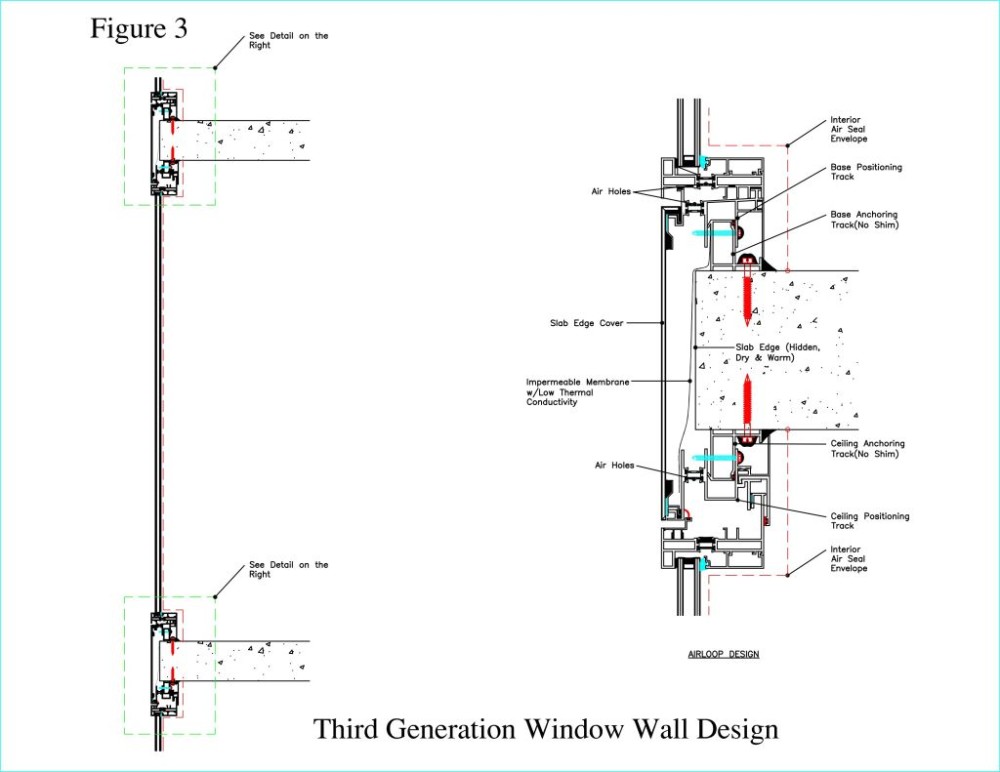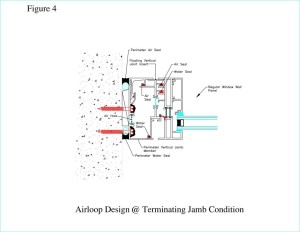Air-loop window walls
by Erik Missio | May 1, 2015 12:42 pm
 [1]by Raymond Ting, PhD, PE
[1]by Raymond Ting, PhD, PE
In the first part[2] of this look at air-loop window walls, this author discussed the importance of solving problems by eliminating causes. In the article, nine potential problems with traditional exposed and covered slab-edge designs were explored.
All these problems could be solved by eliminating their causes, rather than dealing with their effects. In order to understand the unique solution methodology of the air-loop design (shown at right), it can be useful to consider the following extreme example. A parasol prevents excessive sun exposure on one’s skin—this is ‘designing for the effect,’ but it does not eliminate the sun exposure. However, if one were to shoot down the sun (i.e. ‘eliminating the cause’), then the problem is solved forever, and one no longer needs a parasol. (Of course, shooting down the sun might present other problems…)
Finding the solutions
The following solution methodology makes this type of ‘forever solution’ possible:
Step 1: Analyze to determine the real causes of the problem.
Step 2: Use the functional isolation concept (FIC) to separate the causes.
Step 3: Eliminate the separated causes one by one.
This article examines how the air-loop style of window wall can speak to nine common glazing assembly problems by eliminating their causes.
1. Aesthetic problem
Steps 1 and 2: This is a ‘single-cause’ problem, so there is no need for these steps.
Step 3: The cause is eliminated by providing a slab-edge cover—the same solution already found in window walls employing covered slab-edge design.
2. Durable sealing integrity problem
Step 1: Since critical seals cannot last forever, they are the cause of the problem.
Step 2: The critical seal is required due to the double functions of sealing water (infiltration by positive wind pressure or water head pressure in the internal gutter) and sealing air at the same location. Applying FIC means the function of sealing water must be separated from the function of sealing air.
Step 3: The critical seal (i.e. ‘cause’) is eliminated in the air-loop window wall assembly because the air and water seals have been completely separated with instantaneous water drainage.
3. Health problem
Steps 1 and 2: This is a single-cause problem, so there is no need for these steps.
Step 3: The problem is forever solved due to no possibility of water being trapped within the joint cavities for any substantial duration thanks to open-joint design with instantaneous drainage in the air-loop system.
4. Design flexibility problem
Step 1: There are two design functions for the exterior wall surface terminating at the slab surfaces along the base and ceiling tracks: aesthetics and sealing on the exterior wall envelope. To eliminate the aesthetic problem of the protruding exposed slab edge, the exterior wall envelope must be pushed outwardly beyond the slab edge, with a cover installed and field-sealed to restore the exterior wall sealing envelope. The quality of field-executed sealing envelope can be highly questionable.
Step 2: Applying FIC, the aesthetic function must be isolated from the exterior sealing envelope function for the installation of the slab edge cover.
Step 3: In an air-loop system, the locations of structural connection and air-seal envelope are located near the interior surface of the wall with exterior open joints and pressure-equalized joint cavities, with instantaneous drainage mechanism eliminating the sealing function of the slab edge cover. Therefore, this problem can be forever-solved by simply pushing out the exterior wall surface to be flush with the slab-edge cover.
5. Structural slab problem
Step 1: The wall anchoring track has three design functions:
- as part of the wall face for aesthetic function;
- as the horizontal wall support for structural function requiring a minimum slab edge distance for the anchoring fasteners; and
- as part of the exterior wall envelope terminating along the seating slab surface requiring air- and water-sealing function between the track and the slab surface. If the wall face is pushed out to protect the slab edge, it will cause the structural problem due to inadequate slab edge distance for the anchoring fasteners.
Step 2: Applying FIC, the three functions must be isolated in order to solve the problem.
Step 3: First, the anchoring track should be used only for its structural function, with the anchoring point as far away from the slab edge as possible. An open-joint slab-edge cover should be used solely for the aesthetic function, while a pressure-equalized hidden membrane covers the slab for preventing the wetting of the slab edge (i.e. water sealing function with no air sealing function). In an air-loop system, the slab edge is completely protected from ultraviolet (UV) exposure and wetting of rainwater by the drainage membrane cover on the slab edge (i.e. the cause of the problem is eliminated). Therefore, the problem is forever solved.
6. Structural anchor problem
Step 1: The track member provides two functions: structural function to transfer the wind load reaction into the floor slab, and the aesthetic role of positioning the wall lines at the theoretical location with small tolerance. Due to the requirement for adjusting the large variations of the floor slab construction tolerances in the up/down direction, various depths of construction shims are required for the aesthetic function, which causes the problem.
Step 2: To eliminate the use of shims (i.e. the cause), the structural function must be separated from the aesthetic function.
Step 3: In an air-loop system, a two-member track design is employed. The anchoring track (without shim) is used for the structural function while a positioning track is engaged into the anchoring track using the engagement depth adjustment (again without shim for the up/down tolerance adjustment) for the aesthetic function. The problem is forever solved since the cause has been eliminated.
7. Field productivity and quality control (QC) problem
This problem is permanently solved due to the two-member track design as explained in Problem 6.
8. Water leakage problem
Step 1: The cause of the problem is the required dual functions of the terminating jamb member.
 [3]Step 2: Applying the FIC concept, a terminating jamb can be used to seal members—see the image at right—forming the boundary water and air seal with pressure-equalized air in between (i.e. sealing function). The non-structural floating vertical joint insert can maintain the air-loop design between the terminating jamb member and the adjacent window wall panel.
[3]Step 2: Applying the FIC concept, a terminating jamb can be used to seal members—see the image at right—forming the boundary water and air seal with pressure-equalized air in between (i.e. sealing function). The non-structural floating vertical joint insert can maintain the air-loop design between the terminating jamb member and the adjacent window wall panel.
Step 3: In this arrangement, the structural function is maintained by the wall panel and practically no wind load reaction can be transferred into the terminating jamb seal member through the floating vertical joint insert. Therefore, the sealing function is separated from the structural function. The problem is forever solved since the cause has been eliminated.
9. Slab-edge water condensation problem
Step 1: The water condensation on the slab-edge is caused by the surface temperature (Ts) being less than the dewpoint (D) of the surrounding. The dewpoint (D) is determined by the air temperature near the slab edge (Ta) and the relative humidity in the air (RH). The surrounding air temperature is always equal to dewpoint at 100 percent RH or higher than the dewpoint as represented by the following equation:
Ta ≥ D
Due to a warm indoor slab mass, for a slab edge in the ‘exterior air zone,’ the slab-edge temperature is always higher than the surrounding air temperature as represented by the following equation:
Ts > Ta
Combining these two equations results in:
Ts > Ta ≥ D
Since Ts is always higher than D, water condensation on the slab edge will never happen if it is in the exterior air zone.
Due to the slab edge being closer to the cold, for a slab edge in the ‘interior air zone,’ the surrounding air temperature is always higher than the slab-edge surface temperature as represented by the following equation:
Ta > Ts
Combining this with the first equation, there is no definite relationship between D and Ts—therefore, water condensation will occur for the condition of Ts < D. In a conventional window wall design, providing slab-edge insulation is the only method for increasing Ts to reduce the probability of condensation (i.e. ‘design for the effect’), however, it failed to eliminate the problem. Concluding from the above analysis, the cause of this problem is the slab edge being in the interior air zone.
Step 2: The air-loop window wall design places the slab edge in the exterior air zone due to the fact all joint cavities including the air space in front of the slab edge are pressure-equalized to the exterior air (i.e. the cause of the problem is eliminated). Therefore, the problem is forever solved without any slab-edge insulation.
For those accustomed to the second-generation design (i.e. concealed slab-edge), it is easy to continue to think the colder the region, the more slab-edge insulation is required. If one agrees Ts > Ta is always true without any slab-edge insulation, then this problem can be solved forever without needing any slab-edge insulation.
There might be another concern of interior water condensation on the floor slab inside the air-seal envelope in the extreme cold region. However, this is not likely to happen. The mass of the entire floor slab is a huge thermal sink—therefore, any thermal loss by thermal conductivity to the cold slab edge is unlikely to cause the interior slab temperature to go down to below the interior dewpoint.
This was demonstrated in an air-loop curtain wall renovation job in Minnesota where the base floor slab edges were completely exposed to the exterior cold weather without any slab-edge insulation—there has never been any reported interior water condensation on the interior floor slab surface.
In fact, adding the unnecessary slab-edge insulation to this design would have been counter-productive. This is because the effectiveness of the air-loop is to allow the pressurized exterior air due to positive wind to enter all cavities in the system as quickly as possible, and to enable residual water in the system cavities to dry out as quickly as possible after a rainstorm to prevent the possibility of mold growth inside the system cavities.
Securing the slab-edge insulation to the slab edge would reduce the air space in front of it, resulting in a slower rate of air-loop pressurization, as well as the drying of the system cavities. As mentioned earlier, eliminating the sun (i.e. cause of condensation) means no need for a parasol (i.e. slab-edge insulation).
The potential of slab-edge water condensation for hot and humid exterior air conditions is analyzed below, based on third-generation (i.e. air-loop) design only—that is, the slab edge is in the exterior air zone:
Ta > Ts
Combining this with Ta > D, there is no definite relationship between D and Ts. Therefore, water condensation will occur for the condition of Ts < D. However, for the air-loop system, if this is the condition of exterior water condensation, the condensed water will be harmlessly drained out in the instantaneous drainage mechanism, and all system cavities will be dried out quickly.
Again, adding the unnecessary slab-edge insulation would slow down the drying rate of the system cavities and increase the potential of mold growth in this hot exterior air condition.
Conclusion
A window wall has a distinct cost and time advantage over a curtain wall assembly due to easy erection from inside without hoisting equipment from outside. However, technical problems in a window wall system—such as water leakage, water condensation, and aesthetic and structural issues—have prevailed for decades without finding permanent solutions to the problems.
By using the concept of ‘eliminating cause rather than design for the effect’ as described in these articles, permanent solutions to nine major problems can be found. To implement a good air-loop design, the designer must have the courage to abandon some deep-rooted conventional thinking, such as requiring slab-edge insulation, for preventing problems caused by slab-edge water condensation.
 [4]Raymond Ting, PhD, PE, is the president of Ting Wall Inc., an exterior wall system engineering and design company. His expertise is in the exterior wall technology and composite foam panel technology. Ting has been involved in building product/system research and development since 1969, and is the inventor of more than 30 patents worldwide. He can be reached at ting@tingwall.com[5].
[4]Raymond Ting, PhD, PE, is the president of Ting Wall Inc., an exterior wall system engineering and design company. His expertise is in the exterior wall technology and composite foam panel technology. Ting has been involved in building product/system research and development since 1969, and is the inventor of more than 30 patents worldwide. He can be reached at ting@tingwall.com[5].
- [Image]: http://www.constructionspecifier.com/wp-content/uploads/2015/05/Window-Wall-Paper-CF62E0.jpg
- part: http://www.constructionspecifier.com/solving-window-wall-problems-by-eliminating-causes/
- [Image]: http://www.constructionspecifier.com/wp-content/uploads/2015/05/Window-Wall-Paper-CF62F4.jpg
- [Image]: http://www.constructionspecifier.com/wp-content/uploads/2015/04/Ray-Photo.jpg
- ting@tingwall.com: mailto:ting@tingwall.com
Source URL: https://www.constructionspecifier.com/air-loop-window-walls/